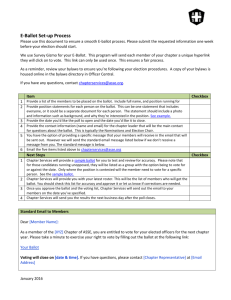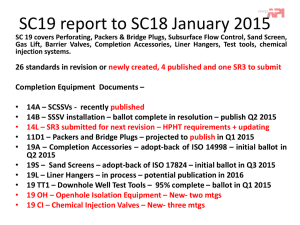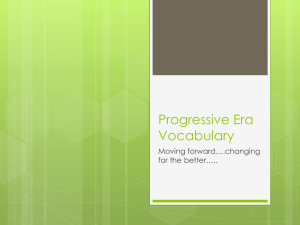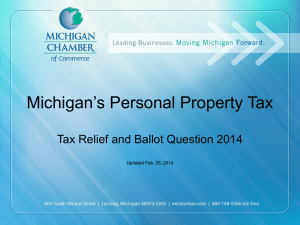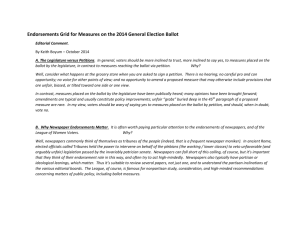Breen Creighton, Catrina Denvir, Richard Johnstone, Shae
advertisement
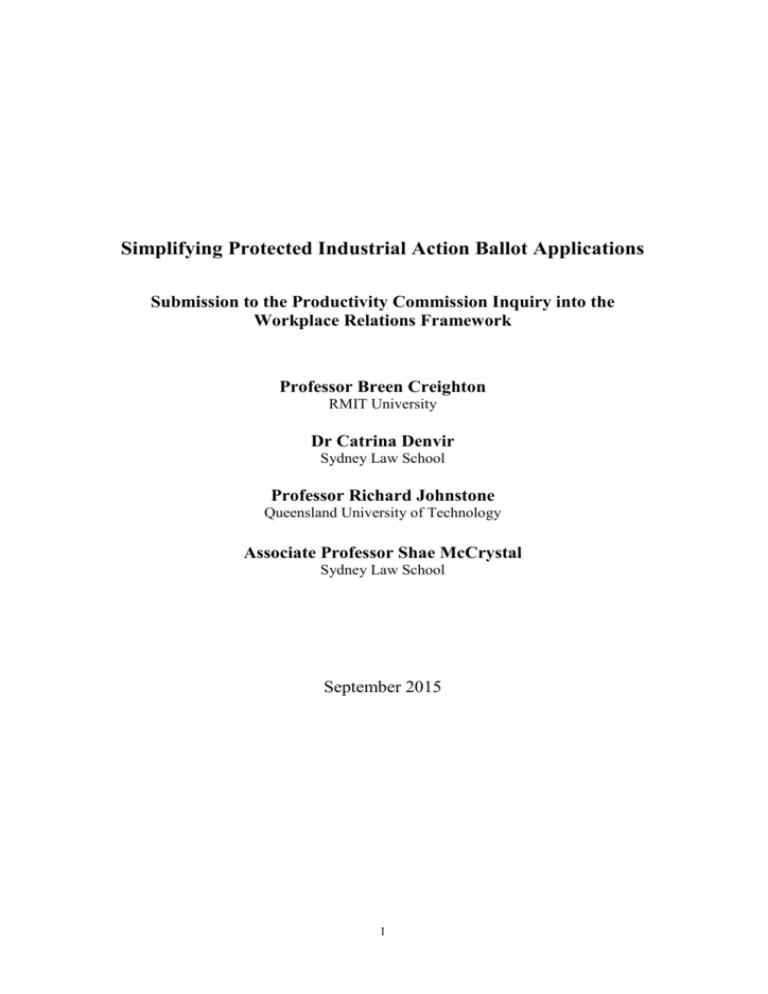
Simplifying Protected Industrial Action Ballot Applications Submission to the Productivity Commission Inquiry into the Workplace Relations Framework Professor Breen Creighton RMIT University Dr Catrina Denvir Sydney Law School Professor Richard Johnstone Queensland University of Technology Associate Professor Shae McCrystal Sydney Law School September 2015 1 This submission addresses points raised in the draft Workplace Relations Framework Report published by the Productivity Commission. In it, we specifically address the Commission’s calls for: …further input from stakeholders on how protected action ballot procedures may be simplified to reduce compliance costs, while retaining the benefits of secret ballots. Potential simplifications include: Removing the requirement that a protected action ballot specify the types of actions to be voted on by employees, and instead simply requiring a vote in favour of any forms of protected industrial action Amending or removing the requirement that industrial action be taken within 30 days of ballot results being declared.1 We address these points by drawing on preliminary data emerging from empirical research conducted by Associate Professor Shae McCrystal, Dr Catrina Denvir (University of Sydney), Professor Breen Creighton (RMIT University) and Professor Richard Johnstone (Queensland University of Technology). As detailed in our earlier submission to the Commission 2 dated March 2015, our research funded by the Australian Research Council aims to facilitate a better understanding of the impact of protected industrial action ballot order provisions on enterprise bargaining behaviour and trade union decision-making. It does this through a ‘point-in-time’ examination of the PABO provisions using a mixed methods approach involving quantitative and qualitative analysis comprised of two components. In the first, we collect and analyse empirical data on all protected action ballot order applications made to the FWC over a 12 month period3 from July 2015 to the end of June 2016. For each of these applications, both the applicant (generally a trade union on behalf of a group of employees) and the respondent (employer) is invited to participate in an interview designed to generate qualitative data concerning decision-making by bargaining representatives and how this relates to the application for a PABO. At the point of writing, 407 applications for protected industrial action ballots have been incorporated into a research database for quantitative analysis and a limited number of interviews have been conducted with both trade union ballot applicants and employer respondents. Given the reference period for the study (July 2015-June 2016) and the preliminary nature of our findings, our observations at this point are limited. Nevertheless there are some important themes emerging, which we draw to the Commission’s attention. 1 Productivity Commission. 2015 Workplace Relations Framework Draft Report. Draft Report, Canberra, p.57 and p.680 2 Creighton, B., McCrystal, S. and Johnstone, R. 2015. Protected Industrial Action Ballot Applications. Submission to the Productivity Commission. March 2015. Available from http://www.pc.gov.au/__data/assets/pdf_file/0010/187615/sub0048-workplace-relations.pdf 3 ≈1,000; based on 1011 for 2011-12. 2 The 30 day Rule The FW Act provides that protected industrial action by employees and their bargaining representatives is restricted to support for negotiations for a singleenterprise agreement, subject to the Fair Work Commission (‘FWC’) authorising a secret ballot of employees to approve the taking of protected industrial action through a protected action ballot order. Pursuant to s 459 of the Act, the action approved by such ballot must commence within 30 days of the ballot outcome. This poses some challenges when it comes to ballots that propose a number of different forms of action. In our analysis of over 400 ballot applications,4 in all but one, ballots have proposed more than one type of industrial action for employees to approve. Such action has ranged from strikes, to job function bans, to bans on overtime and are typically proposed in one of three ways: As a single question, incorporating within it a number of actions;5 As a series of multiple yes/no questions, or;6 As a series of multiple questions with a single vote to approval all actions.7 Our preliminary research indicates, the formulation of questions does not appear to have any effect on the ballot result. Whilst exploration of ballot results does show 4 It should be recognised that 407 ballot applications between the reference start date (July 2015) and the present date is an unusually large sample. Typically, a 12 month period will yield between 600 and 1000 applications for protected industrial action to the Fair Work Commission. However, over 290 applications derived from enterprise bargaining negotiations taking place between the Independent Education Union of Australia and the Catholic Education Office on behalf of a large number of Independent Catholic Schools in Queensland. 5 E.g. ‘In support of reaching an enterprise agreement with your employer, do you endorse the taking of protected industrial action by [Trade Union] members against your employer, which may involve taking separately, concurrently and/or consecutively any or all of the actions set out below: 1 hour stoppages of work; 2 hour stoppages of work; 3 hour stoppages of work; 4 hour stoppages of work; 8 hour stoppages of work; 12 hour stoppages of work; 24 hour strikes; 48 hour strikes; 72 hour strikes; strikes for a period of one week; indefinite strikes; indefinite or periodic bans on overtime, indefinite or periodic partial work bans. Yes/No.’ 6 ‘In support of reaching an Enterprise Agreement with [the Employer] do you authorise protected industrial action against your employer, separately, concurrently and/or consecutively in the form of: i) An unlimited number of stoppages of work of 4 hours duration? Yes/No ii) An unlimited number of stoppages of work of 24 hours duration? Yes/No iii) An unlimited number of stoppages of work of indefinite duration? Yes/No’ 7 “’Do you, for the purpose of advancing claims in the negotiation of an enterprise agreement between [name of employer] and its employees. Represented by the Union, authorise industrial action against the [Employer Name] which may involve you and/or other employees engaging in any or all of the following forms of action: i) The wearing of campaign badges, stickers or clothing: and ii) an unlimited number of stoppages of work for 30 minutes duration which may be taken separately, concurrently or consecutively; and iii) an unlimited number of stoppages for work of 60 minutes duration which may be taken separately, concurrently or consecutively; and iv) an unlimited number of stoppages of one day's duration Yes/No’ 3 that when posed separately, certain forms of action may elicit greater or lesser support than other forms of action, the preference for single questions or multiple questions is explained by Union representatives as a stylistic rather than strategic function. Where ballot questions approve multiple forms of action, the Federal Court’s interpretation of the pre-cursor provision in the WR Act in United Collieries Ltd v CFMEU (hereafter ‘United Collieries’)8 appears to have become settled law. This case interpreted the WR Act equivalent to s 459(1)(d) to mean that the relevant ‘action’ can only be said to have commenced within 30 days if that particular form of action has commenced. Accordingly, in ballots where multiple forms of action are proposed, each form of action must be undertaken within 30 days of the ballot vote, in order for employees to retain the right to use that particular action after 30 days has passed. It seems to be only where action is considered to be so similar as to be indistinguishable, that a more generous interpretation of the rule might be warranted.9 While this interpretation does not appear to have been specifically affirmed or challenged by the FWC or the Courts interpreting the FW Act,10 it has been implicitly accepted in cases where extensions of the 30 day time period have been granted in situations where some forms of industrial action approved in a ballot have been taken, but not others.11 Further, the Full Federal Court in Energy Australia Yallourn Pty Ltd v CFMEU referred to the authorisation for the taking of prospective and ‘particular’ industrial action being rendered ineffective if it is not acted upon within 30 days of the ballot result.12 Our analysis of ballot applications from July 2015 onwards has highlighted that although ballots propose, on average, about seven types of action which voters can approve,13 there have been instances where applications have been submitted listing 40 different types of action. The approach taken by the Courts and the FWC to s 459(1)(d) may therefore lead to a ‘rush’ to take protected industrial action within the 30 day period. Our preliminary research interviews have shown that many employers interviewed so far, perceive this to be a real risk and have noted in observation that in smaller workplaces, this can lead to a situation in which what is intended as collective action may only be taken by one or two individuals in isolation due to the time constraints imposed. Conversely, interviews with Union representatives have indicated that they would sooner submit an application for extension than rush to use different forms of action. 8 (2006) 153 FCR 543. See e.g. University of South Australia v NTEU where staff were considered to have activated ‘a ban on the recording and transmission to the University, of assessment and exam results’ simply by having instigated a ban on the transmission of assessments. Although the syntax of the statement implied assessment and exam results were two different types of activity, the Court viewed an ‘exam’ as a form of assessment. 10 It was expressly applied by the AIRC with respect to the WR Act in cases such as HSU v Healthcare Imaging Services Pty Ltd [2009] 181 IR 111 and Cadbury Schweppes Pty Ltd v CEPU [2009] AIRC 1098. 11 See eg Australian Rail, Tram and Bus Industry v Aurizon Operations Ltd [2015] FWC 117; Energy Australia Yallourn Pty Ltd v CFMEU (2013) 233 IR 223. 12 (2014) 218 FCR 316, North and Bromberg JJ at [15]. 13 Min= 1, Max = 40, Average = 7.3, Standard Deviation = 4 based on 407 ballot applications. 9 4 Rushing in order to retain options was indirectly flagged by a number of union representatives as strategically unwise, particularly since action was often framed in a manner that afforded escalation in response to negotiations (e.g. commencing with 15 minute stoppages and working up to indefinite stoppages). That is not to say that such rushing does not occur, but rather that it has been recognised as a less satisfactory outcome. One way of exploring whether the 30 day rule is excessively onerous is to examine how many applications for extensions have been submitted to the FWC. If we take all ballot applications submitted since the 1st of July 2015 to the time of writing (407 ballots in total), of these applications 77 could possibly have reached the conclusion of the ballot vote (considering the time taken to approve the ballot and conduct the ballot). Of these, 54 ballots had been conducted, and of these, only 17 had reached the end of the 30 day post-ballot period. Of these 17, we note four applications for an extension to the 30 day period were made which accounts for 24 per cent overall. This number is similar to figures reported by the FWC in their quarterly reports, where during the reporting period January to March 2015 of the 99 ballot orders made, 28 requests for extension were submitted amounting to 28 per cent.14 With applications for extensions required for over a quarter of all successful industrial action ballots, the extension process does present an additional compliance cost to unions. This needs to be weighed against the potential implications for ‘rushing’ through taking various forms of action within the 30 days in order to retain the right to use it thereafter. However, a closer examination of the ballot questions reveals that ‘rushing’ or ‘extending’ are not the only two options available to unions and members. There is evidence that in order to maximise the timeframe available, those drafting ballots will often tweak the wording of ballot questions in a strategic manner. Voters are almost always asked to approve action that takes place ‘separately, concurrently or consecutively’. As a result of this, where a ballot approves 4 hour, 8 hour, 12 hour and 24 hour strikes, workers can take the 24 hour strike and give notice that they are simultaneously taking the 4, 8 and 12 hour strike at the same time as the 24 hour strike. From a union perspective, this is an efficient way to ‘activate’ a number of actions on the ballot, it is easy to coordinate employee action and it merely requires that the employer be given notice that the actions will all occur simultaneously. An alternative form of words used to counteract the challenge of activating a number of different types of action is to approve action, which spans a broader period of time, e.g. ‘an unlimited number of periodic stoppages of work’. This syntactic strategising shows how the Court and the FWC approach to s 459 has led to an unnecessary level of complexity in compliance as well as a juridification of something that, according to its’ object, is supposed to be ‘simple’ (FW Act s 436). Although these mechanisms provide a way around the 30 day rule we argue that this does come at a cost. When employees are rushed into taking action, or feel compelled 14 FWC. 2015. Third Quarter Report to the Minister. Schedule 5.2, Part 1 Report. Available from https://www.fwc.gov.au/documents/documents/quarterlyreports/minister-3Q-FY14-15.pdf, accessed 2/09/15. Caution must be exercised in relation to the latter figure since the numbers reflect the number of orders made during the timeframe specified. There is a risk that extensions granted relate to orders made prior to the collection period, and conversely, that orders made may have requested extensions outside of the data collection period. 5 to jump to longer stoppages of work so that they can concurrently undertake shorter stoppages of work, action is unlikely to be used in a manner that appropriately responds the progress of bargaining. If part of the intent of the legislation is to promote a reduction in industrial action (and in particular the more acute and costly forms of action, e.g. indefinite stoppages), then restricting the use of this action to 30 days under a ‘use it or lose it’ approach is likely to thwart the natural course of the bargaining process. By forcing employees to take action to keep their options open, it impedes escalation or de-escalation of industrial action in response to bargaining gains or set-backs. While it is reasonable to expect that employers should not be under the threat of action for an indefinite period, a longer window within which employees can take action may facilitate rather than hinder the bargaining process. To this end, if it is considered that a post-ballot timeframe should be retained, there is merit in extending the initial period to at least 60 days and allowing no extensions thereafter. This will not guarantee against a ‘rush’ to use action (particularly where the number of actions that employees elect to support in a ballot rise in line with an extended period within which to take such action), but it would certainly address some of the issues that we see emerging in our preliminary data. It will also reduce the administrative burden borne by both the FWC and employees and their bargaining representatives in complying with the legislation. We also suggest that the Productivity Commission recommend that s 459 be amended to overrule United Collieries and provide that the mandate of the ballot will attach to all industrial action taken by employees and their bargaining representative, as long as at least one instance of any industrial action occurs within a time-frame specified under the Act. This amendment would also complement a change to the requirement that a protected industrial action ballot specify all of the different forms of action proposed, and it is to this issue that our focus will now turn. Ballot Specificity The FW Act requires that employees must specify the type of action they propose to undertake when submitting an application for a protected industrial action ballot under s 459(1)(a). In addition, they must provide employers with written notice of their intention to take particular action under s 414(1) three days prior to commencing the action, or longer if this is specified in the ballot order (s 414(2). A notice of proposed industrial action must specify the nature of the action and the day on which it will start (s 414(6)). To be protected, the action taken must be the action specified in the notice. The intent behind the notification process has been explained as a means to ensure that: ‘disputants who are to become affected by protected action in relation to which their legal rights are significantly diminished are at least able to take appropriate defensive action’.15 While the Federal Court has been prepared to intervene where a notice is said to fail adequately to state the nature of the intended industrial action, the FWC has also observed that while the ballot questions should describe the industrial 15 David’s Distribution Pty Ltd v NUW (1999) 91 FCR 464 at [87]. 6 action in such a way that employees are capable of responding to them, ‘in most cases the drafting of the questions will be a matter for the applicant’.16 Tribunal and Federal Court decisions have recognised the need to balance the rights of the employer in knowing what action will occur and when, against the right of the notice giver to engage in protected industrial action, and to avoid approaching the requirement in a technical and legalistic manner.17 The Productivity Commission is right to question the need for applicants to specify the nature of the action they wish to take, both at the ballot application stage and at the notification stage. We argue that this provides employers with two avenues under which they can challenge the proposed action and gives employers a potential tactical advantage in the negotiating process. We suggest that specifying the form of action to be taken in a vote is not necessary under the principles of democratic accountability; nor is it necessary to enable employers adequately to ‘prepare’ themselves for action since it is not until the second notification that they are aware of exactly which action employees intend to take. Stalling & Notice Periods At the same time, notification at the ballot stage and at the point before which action is taken, do serve an important purpose. Under the current law, it is only at the point of application that employers can request longer notice periods (as per s 414(2)) and it is often only upon considering the type of action employees wish to undertake that employers can determine how much extra notice they may need. Case law has shown that extensions will generally be granted where the nature of the work involved means that harm could be inflicted upon the employer or its clients that is beyond the ordinary spectrum of expected damage from industrial action, and such extension is necessary for the employer to take additional steps to minimise those potential consequences. 18 Essential services are not automatically considered exceptional; rather it is a question of fact in each case considering the nature of the proposed action and the particular circumstances of the work.19 Any reform of the law aimed at simplicity and efficiency should avoid a situation in which a lack of specificity at the ballot application stage gives employers the opportunity to challenge each notice on the basis that they require a greater warning period. A better balance might be struck between competing interests if ballot 16 John Holland v AMWU (2010) 194 IR 239 at [19]. Alcoa of Australia Limited v AWU (2010) 196 IR 103. See eg CFMEU v Yallourn Energy Pty Ltd (2000) 100 IR 52; CEPU v Pinnacle Career Development Pty Ltd (2010) 190 FCR 581; John Holland Pty Ltd v AMWU (2010) 194 IR 239. 18 See eg AIMPE v The Commonwealth Government – Australian Customs and Border Protection [2011] FWA 6882 (7 day notice period relating to customs work and potential impact on the national interest); AMIEU v Coles Supermarkets Australia Pty Ltd T/A Coles Supermarkets [2015] FWC 1567 (4 and 5 day notice period in relation to industrial action affecting produce likely to spoil or waste); NUW v Aspen Pharma Pty Ltd [2015] FWC 597 (5 days notice of industrial action likely to affect the supply of pharmaceuticals to patients). 19 See eg CPSU v G4S [2011] FWA 2115 (5 day notice period for 2 hour stoppages in a maximum security prison where stoppages could affect prisoner transport of seriously ill prisoners); CPSU and United Voice v State of Victoria [2012] FWA 6355 (5 day notice period for industrial action affecting students with special needs). 17 7 applications were permitted to remain silent as to the type of action proposed, but employers could request an extension for certain (specified) activities that are likely to give rise to harm that is out of the ordinary. Signalling & Strategy As a result of the requirement that ballots specify the forms of industrial action proposed, ballot results perform a signalling function. Where questions are posed separately, the responses to each of the questions can indicate whether certain actions have attracted more support than other actions. In an environment of information asymmetry, this gives an employer cues as to which proposed actions are supported by employees. Employees who strongly support even the most disruptive of industrial action demonstrate strong commitment to the bargaining position of their representative. However, where support for certain types of action is weaker (even if the action is approved), this suggests that certain sub-groups of employees feel less willing to participate or to make significant personal sacrifices in order to achieve collective aims. These cues can offer employers a tactical advantage in the negotiating process. On the other hand, one of the potential criticisms of a regulatory environment in which specificity is not required in the ballot application process, is that without a clear indication of the level of support for different forms of action, employees may be exposed to pressure to participate in industrial action that they did not originally anticipate as an option. One of the continuing themes underpinning a shift to a ballot process was the notion that in the absence of a democratic vote, employees could be cajoled into taking industrial action in which they did not wish to engage. When considering whether to the remove the specificity requirement, a key issue is whether the same risk is run when employees are not notified in advance of the forms of action contemplated. The question that arises is whether the ballot process is intended to democratise support for industrial action irrespective of the form it takes, or about ensuring that employees know in advance exactly what they are agreeing to. This question assumes that it is only during the ballot vote that employees come to learn of the types of action in which they are being asked to participate. Were it the case that individuals had no idea of the action expected of them until they went to vote, we would expect to see a much higher level of certain actions being voted down in a secret vote. It is unlikely that in every instance a Union would have perfectly predicted the forms of action an employee group was willing to take, without ever having consulted them. It is equally unlikely that members would be so flexible as to the action they were willing to take (particularly given the personal economic costs) that they would submit to the authority of unions without question. Union officials reject the idea that certain forms of industrial action are proposed without employee consultation. Indeed, in many industries consultation with employees and employee representatives is crucial in determining what types of industrial action should be proposed, since work bans of a technical nature must be accurately described. There is no evidence to suggest that bargaining representative consultation with employees would change if the requirement to specify the forms of notice in the ballot was removed. Furthermore, it remains the case that the most 8 effective and persuasive forms of action are those undertaken collectively. This necessitates ongoing consultation with an employee group to ensure that any action proposed is action that they will support, both in principle and in practice. This is further reinforced by reference to some of the comments emerging from our research interviews with union organisers. While some unions ask members to vote to support only action that they are prepared to take, others treat the ballot as a two-step process. In the first, individuals are asked to support the industrial action – not necessarily because it will be taken, but because it can offer leverage in the negotiations. It is only after a ballot is approved that actual action will be contemplated, and at this stage, workers must necessarily be consulted via the union’s informal democratic procedures, to determine if they still support certain actiontaking place on a certain day. It is true that, for employees, specifying action allows them privately to consider how far they are prepared to go and what economic losses they are prepared to bear in support of the action. However, the requirement to specify action is less about the benefits it provides for employees, and more about the benefits it affords employers who can implement strategies to mitigate the interruption that industrial action produces. Conclusion We stress the preliminary nature of our findings and our expectation that our ongoing fieldwork will yield deeper insights. Nonetheless, our research tends to support the PC’s view that the 30-day requirement requires amendment. We suggest abolishing this requirement, or at very least extending it to 60 days without further ability to extend, should a time period be considered appropriate. A 60 day period would provide adequate time for employees to commence industrial action, whilst reducing compliance costs associated with applying for an extension. Such a change should be accompanied by a provision expressly overruling the effect of the decision in United Collieries requiring each action to be commenced within that period. This change would allow negotiations to progress without employees feeling compelled prematurely to escalate action to retain the right to use it after the first 30 days. We suggest that specificity at the ballot stage become an option, rather than a requirement, and we expect that the informal democratic processes that guide members interactions with their unions will dictate the level of specificity that follows in the vote. This will not prevent applications for interim injunctions on the basis that the notice provided does not specify the action sufficiently, but would avoid the potential for employers to challenge industrial action at both the ballot stage and the notice stage. 9
